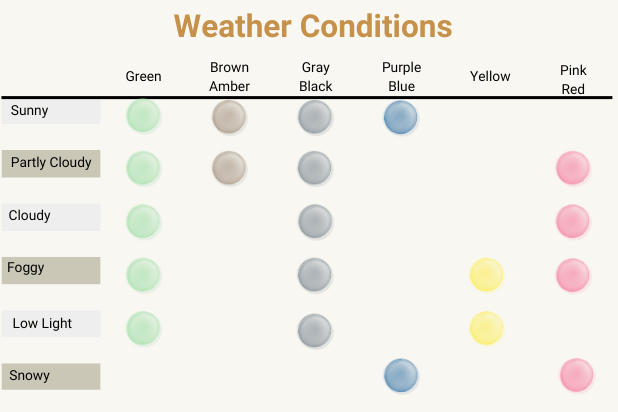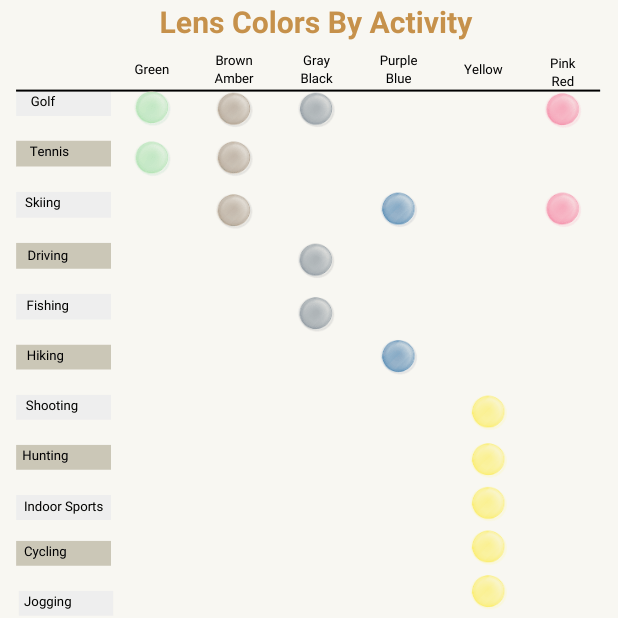Sunglass Lens Colors Complete Guide
Sunglass lens tint colors are important for improvements in visual comfort and sports performance, protection for your eyes, and expression of your personal style. You may want to try on sunglasses with various lens colors to determine which ones you prefer for the best combination of comfort, visual clarity, and style. Here's a comprehensive guide to different sunglass lens colors, their benefits, and the best conditions to use each color:
Does the color of the sunglass lens matter?
The color of sunglass lenses is more than just an aesthetic choice; it will determine the performance of your sunglasses for different occasions. The color of a sunglass lens matters because certain colors are better for various lighting conditions and activities. The lens color affects visual comfort, clarity, performance, and experience.
Benefits of lens colors and tint
There are several benefits to choosing a lens color or tint for your sunglasses, including customization for the lighting conditions, a sport or hobby, and your own preference. Adding a different lens color or tint to your sunglasses can enhance your comfort, reduce glare, and improve contrast.
The importance of UV protection
Protecting your eyes from the sun’s dangerous rays is extremely important. Ultraviolet (UV) rays are invisible forms of radiation emitted by the sun. Unprotected exposure to UV radiation can damage your eyes and skin. Sunglass lenses should have both UV-A and UV-B protection. UV exposure can cause cornea damage (photokeratitis), cataracts, macular degeneration, and cancers of the skin and eyes.
UV radiation is present in the atmosphere even on cloudy days and during the winter. Snow and water also reflect and intensify UV rays and increase your risk of sun damage.
Lens Colors By Weather Condition

Certain lens colors are best for specific weather conditions.
Green Lenses
Green-tinted lenses are ideal for both sunny and low-light conditions. They are a great all-purpose lens, no matter the lighting condition outdoors. Green lenses combine the functions of both gray and brown lenses. They provide better color perception than brown lenses and higher contrast than gray lenses. Find out more about green lenses here.
Brown or Amber Lenses
Brown or amber-tinted lenses are also very popular. They are best for bright, sunny environments but can also be worn on partly cloudy days.
Gray or Black Lenses
Gray or black is the most common tint for a sunglass lens. They provide enhanced optics and clear vision on sunny or cloudy days. Colors will look the truest through a gray-tinted lens. They provide the best color enhancement and protection against glare. If you’re looking for a lens tint you can use daily, select gray.
Purple or Blue Lenses
Blue-tinted lenses effectively reduce glare, so they are best for bright and high-glare environments like sunny days, snowy days, or days out on the water. They are also popular with fashionistas.
Yellow Lenses
Yellow lenses are best for enhancing contrast in low-light conditions by filtering blue light. They are recommended for overcast, foggy, low-light conditions like early mornings or late afternoons. The tint will not be dark enough in bright sunlight.
Pink or Red Lenses
Pink or red tints are best for increased contrast in overcast or foggy conditions. They will improve your depth perception and enhance your driving visibility. They are also known for improving eye fatigue and may be more comfortable for longer hours of wear.
Comparison of Sunglass Lens Colors: Features & Benefits
| Lens Color | Advantages | Disadvantages |
|---|---|---|
| Green | Improve natural color | Not dark enough in bright conditions |
| Brown or Amber | Enhance contrast and depth perception | Alter color perception |
| Grey or Black | Darkest tint in bright sunlight, best overall choice | May be too dark in mid-moderate lighting conditions |
| Purple or Blue | Modern, fashion-forward style | Alter color perception |
| Yellow | Great for activities that require a quick shift of focus | Tint may be too light for bright sun levels. |
| Pink or Red | Reduce eye strain and fatigue | Less glare reduction, and altered color perception |
Lens Colors By Activity

Depending upon the sport, activity, and lighting conditions, one may prefer one tint color over another.
Green Lenses
Green lenses provide good contrast, visual clarity and maintain the natural color of the world. Green lenses are best for outdoor activities like golf or tennis but in low-to-mid lighting levels.
Brown or Amber Lenses
Brown or amber lenses enhance contrast and depth perception but do alter the color. Brown lenses are best for outdoor activities like tennis, skiing, and golf, where depth perception and contrast are important.
Gray or Black Lenses
Gray lenses offer the best true color perception by reducing brightness without altering color. Gray or black lenses are best for outdoor activities in bright conditions, like driving, golfing, fishing, or other outdoor sports. They reduce glare from surfaces like wet roads, snow, or off the water.
Purple or Blue Lenses
A purple or blue lens will reduce glare, enhance contrast, and minimize haze and glare. If you like hiking, skiing, or participating in sports under bright conditions, you may prefer a blue or purple sunglass lens.
Yellow Lenses
Yellow lenses enhance contrast and depth perception and are beneficial for specific sports where visual clarity is crucial. Yellow lenses are popular for shooting, cycling, hunting, jogging, or for indoor sports like basketball, racquetball, and volleyball, where artificial lighting may cause difficulty seeing. Yellow lenses are often preferred by baseball players, pilots, and gamers, who must quickly shift their focus from one thing to another.
Yellow lenses can also increase your visibility on trails in shaded or forested areas. They improve your ability to see changes in terrain, roots, and rocks.
Pink or Red Lenses
Pink or red lenses provide good contrast, enhance details, and are beneficial in many lighting conditions. Pink or red may be preferred by athletes for golfing, skiing, and other outdoor sports.
Choosing the Best Tint for You
When choosing the best tint for you, consider your hobbies and activities, the lighting conditions you'll be in, and your own preferences. Before selecting a tint, you may want to try on different lens colors from Overnight Glasses to see how they affect your vision and the environment. If you are unsure, green, brown, and gray tints are most commonly selected and have the best overall use. Explore our wide range of tints today and find the perfect fit for your eyewear needs!
Conclusion
Sunglass lens tint colors are not merely about appearance; they play an important role in enhanced visual comfort, protection from the sun, and optimal performance in various lighting conditions. Each lens color offers unique benefits and advantages for specific hobbies, sports, and environments.
